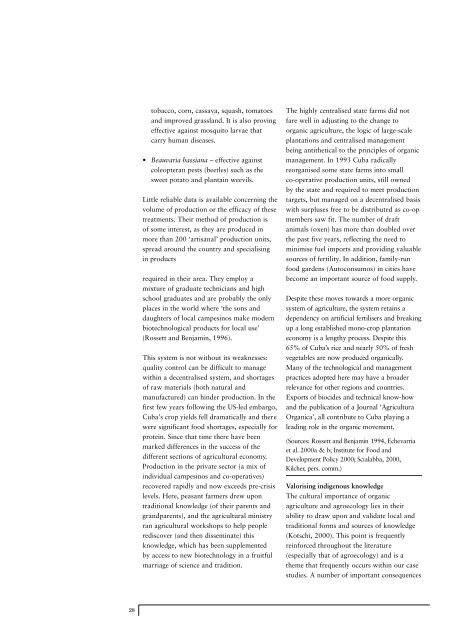The Real Green Revolution - Greenpeace UK
The Real Green Revolution - Greenpeace UK
The Real Green Revolution - Greenpeace UK
Create successful ePaper yourself
Turn your PDF publications into a flip-book with our unique Google optimized e-Paper software.
tobacco, corn, cassava, squash, tomatoes<br />
and improved grassland. It is also proving<br />
effective against mosquito larvae that<br />
carry human diseases.<br />
• Beauvaria bassiana – effective against<br />
coleopteran pests (beetles) such as the<br />
sweet potato and plantain weevils.<br />
Little reliable data is available concerning the<br />
volume of production or the efficacy of these<br />
treatments. <strong>The</strong>ir method of production is<br />
of some interest, as they are produced in<br />
more than 200 ‘artisanal’ production units,<br />
spread around the country and specialising<br />
in products<br />
required in their area. <strong>The</strong>y employ a<br />
mixture of graduate technicians and high<br />
school graduates and are probably the only<br />
places in the world where ‘the sons and<br />
daughters of local campesinos make modern<br />
biotechnological products for local use’<br />
(Rossett and Benjamin, 1996).<br />
This system is not without its weaknesses:<br />
quality control can be difficult to manage<br />
within a decentralised system, and shortages<br />
of raw materials (both natural and<br />
manufactured) can hinder production. In the<br />
first few years following the US-led embargo,<br />
Cuba’s crop yields fell dramatically and there<br />
were significant food shortages, especially for<br />
protein. Since that time there have been<br />
marked differences in the success of the<br />
different sections of agricultural economy.<br />
Production in the private sector (a mix of<br />
individual campesinos and co-operatives)<br />
recovered rapidly and now exceeds pre-crisis<br />
levels. Here, peasant farmers drew upon<br />
traditional knowledge (of their parents and<br />
grandparents), and the agricultural ministry<br />
ran agricultural workshops to help people<br />
rediscover (and then disseminate) this<br />
knowledge, which has been supplemented<br />
by access to new biotechnology in a fruitful<br />
marriage of science and tradition.<br />
<strong>The</strong> highly centralised state farms did not<br />
fare well in adjusting to the change to<br />
organic agriculture, the logic of large-scale<br />
plantations and centralised management<br />
being antithetical to the principles of organic<br />
management. In 1993 Cuba radically<br />
reorganised some state farms into small<br />
co-operative production units, still owned<br />
by the state and required to meet production<br />
targets, but managed on a decentralised basis<br />
with surpluses free to be distributed as co-op<br />
members saw fit. <strong>The</strong> number of draft<br />
animals (oxen) has more than doubled over<br />
the past five years, reflecting the need to<br />
minimise fuel imports and providing valuable<br />
sources of fertility. In addition, family-run<br />
food gardens (Autoconsumos) in cities have<br />
become an important source of food supply.<br />
Despite these moves towards a more org a n i c<br />
system of agriculture, the system retains a<br />
dependency on artificial fertilisers and bre a k i n g<br />
up a long established mono-crop plantation<br />
economy is a lengthy process. Despite this<br />
65% of Cuba’s rice and nearly 50% of fre s h<br />
vegetables are now produced org a n i c a l l y.<br />
Many of the technological and management<br />
practices adopted here may have a bro a d e r<br />
relevance for other regions and countries.<br />
E x p o rts of biocides and technical know-how<br />
and the publication of a Journal ‘Agricultura<br />
O rganica’, all contribute to Cuba playing a<br />
leading role in the organic movement.<br />
( S o u rces: Rossett and Benjamin 1994, Echevarr i a<br />
et al. 2000a & b; Institute for Food and<br />
Development Policy 2000; Scialabba, 2000,<br />
K i l c h e r, pers. comm.)<br />
Valorising indigenous knowledge<br />
<strong>The</strong> cultural importance of organic<br />
agriculture and agroecology lies in their<br />
ability to draw upon and validate local and<br />
traditional forms and sources of knowledge<br />
(Kotschi, 2000). This point is frequently<br />
reinforced throughout the literature<br />
(especially that of agroecology) and is a<br />
theme that frequently occurs within our case<br />
studies. A number of important consequences<br />
28




![[2007] EWHC 311 - Greenpeace UK](https://img.yumpu.com/22079793/1/184x260/2007-ewhc-311-greenpeace-uk.jpg?quality=85)












